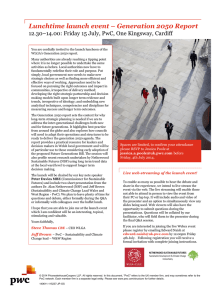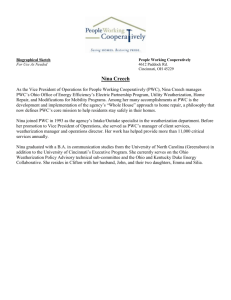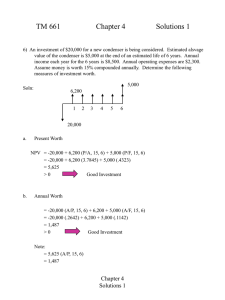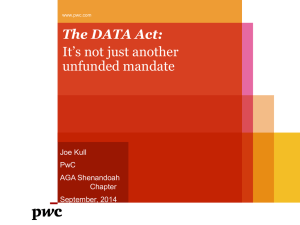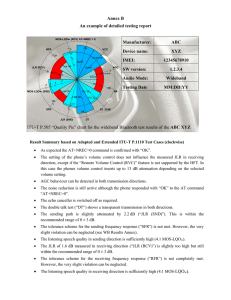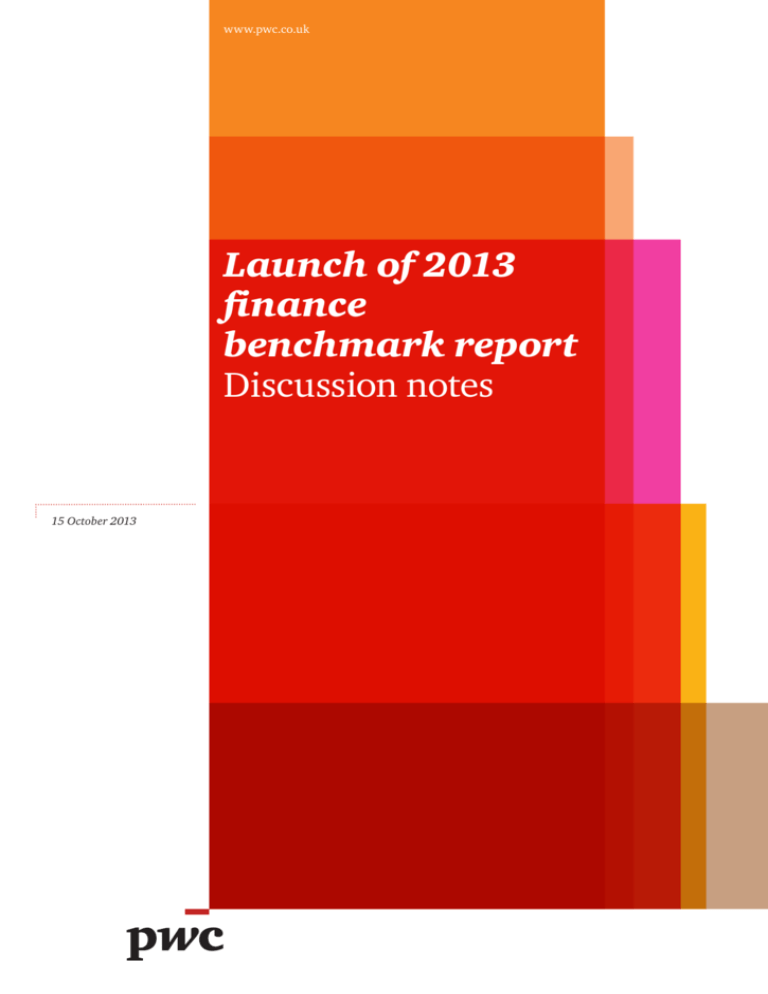
www.pwc.co.uk
Launch of 2013
finance
benchmark report
Discussion notes
15 October 2013
Topic
What are the key findings from our benchmarking data and what are finance
functions doing about it?
Speakers
Terry McConnell, Head of Shared Services, British American Tabacco (BAT);
Adrian Cadman, Corporate Finance Controller, Jaguar Land Rover (JLR) and
Derek O’Gara, Group Finance Director, Divisions, the BBC.
Key findings
There is still a big gulf between the expectations of the business and what finance actually delivers.
• The cost of finance as a
percentage of revenue is
stabilising. Yet there is still a large
gap between top quartile firms
(0.6%) and typical firms (0.9%).
This also tends to vary depending on
the nature of the industry, with
higher costs in the more regulated
industries such as Financial Services,
and much lower costs in low margin,
high transaction businesses such as
retail and travel. However, it is
interesting that whether in the high
cost or low cost groups, there is still
similar wide variability between the
median and top quartile performers.
• Steady upward trend in the
percentage of finance effort being put
into providing more insight to the
business. The leading firms
spend 1/3 more of their time on
analysing and interpreting the
data than the average, but even
they are spending over 50% of
their analyst effort just getting
the numbers right.
• Data gathering continues to
require a substantial amount
of time – 53% of time for top
quartile performers and 64% for
average organisations.
• Progress has been made in
accelerating budgeting and
forecasting, – yet only 45% believe
that their forecast outputs are
reliable.
• There is still a strong debate over
what systems or technology finance
should invest in – but there should be
more focus on the actual data with
only 11% having applied a
standard data taxonomy.
2 | Launch of 2013 Finance Benchmark Report | PwC
Key themes
Further evolution of the finance
function: aligning the operating
model to the business. Insightgeneration and finance-business
partnering.
Technology and automation:
getting technology and data right to
have an impact on business strategy &
insight.
Talent: having the right people with
the right skills and capabilities. How do
you engage people in the change and
transformation process?
Panel discussion and Q&A
Does the data vary depending
on geography and size of
company?
Yes. Absolutely. Complexity of the
business (the number of business units,
or number of countries in which the
business operates) drives cost upwards,
while bigger companies achieve some
economies of scale. Companies need to
make sure they are picking the right
data set to benchmark against. The
bigger and more complex companies can
achieve good performance, for example
our analysis shows that median FTSE
100 companies actually report faster
than their FTSE 250 equivalents, but
that faster process costs the typical FTSE
100 disproportionately more. [Note that
there is a convergence of costs for the
top performers in both categories].
Is there one company that
scores highly in everything?
Or is one area always
sacrificed at the expense of
another?
The overall assessment takes a view of
the total performance, with a focus on
speed and cost of transactional processes,
but quality and impact of insight. We see
companies that are excellent in specific
processes, but there are few if any that
combine low cost and high effectiveness
across the board. This is very much why
we analyse process-by-process and
identify areas for improvement and areas
that should be left alone.
What are your key takeaways
from the findings and how do
they influence your finance
function?
BAT use the findings to see what the
leading finance functions are doing and
determine how they can adapt ideas to
their own journey and leverage the
operating model that they have
developed. Terry described the BAT
focus on both efficiency AND
effectiveness at the same time. They
look to build in best practice as they
develop the organisation rather than
push directly for cost savings and
subsequent process improvement.
For the BBC, they are tackling the
‘effectiveness’ agenda through a finance
change programme. They haven’t tried
to hit the best metric but they have used
a balance scorecard approach and used
the data to set objectives for their
change programme. They are one of the
17% that have a self-service reporting
application but they have not applied a
standard data taxonomy. They are
actively looking to increase automation
and provide more self-service
technology. At the same time they are
keen to invest in improving the calibre
of their people.
JLR are focussed on business insight and
efficiency around forecasting days. They
addressed 3 core issues including (i) the
credibility of date – what is it telling us?
(ii) people capability – moving from
PwC | Launch of 2013 Finance Benchmark Report | 3
spreadsheet jockeys into real
business insight roles (iii) getting the
data right – which has been crucial
– for example to managing cost and
cash, and the most important
component to the survival of their
business.
How has Integrated
Business Planning helped
you be more agile in your
business?
From 2008/9, the JLR business was
shifting, yet the systems and people
were not moving with the times. A
lack of investment and silo mentality
meant that the data and systems
were not forcing people to
collaborate and talk with one
another and the planning process
was consuming vast amounts of staff
time.
In order to build credibility, you must
have the support of your people. So
JLR began the ‘stepping stone’
process. In order to prove credibility
in the financials, JLR initially
focussed on actuals. Having
demonstrated a firm hand on the
results, the next phase was to
understand the cash outcome of
decisions around allocation of build
capacity, depending on model and
derivatives by market, this has given a
platform that encourages and enables
those previously in silos to cooperate.
Plotting actuals against plan helps flush
out bad behaviours.
For JLR, Integrated Business Planning is
at the heart of where finance should be
going. Often finance spends all its time
reporting but no time actioning and
delivering results. It is up to finance
leaders to challenge the purpose of
forecasting – do we do it as a sanity
check or will it challenge and drive the
business? JLR are now focussed on
challenging these assumptions and
changing behaviours.
What is the trick to engaging
people and continuing to
develop finance talent during
a change programme?
In the BBC’s experience, they started by
talking to business stakeholders and
their finance people, looking for the
gaps and then addressing them. The top
performing finance people (20% of
headcount) were taken out of the
business to work on the finance change
programme. They were surrounded by
business people (and PwC consultants)
and together they helped shape the best
solution. They also provided input to
4 | Launch of 2013 Finance Benchmark Report | PwC
their teams through workshops, town
halls and roadshows. This helped to
generate enthusiasm around the change
programme, resulting in people with
better skills, better jobs and ultimately
providing a better service. The key is to
invest in learning and development and
provide opportunities through
mentoring and external training.
How can finance link their
plans for change with the
overall business strategy?
At BAT, there were a number of
executive changes in a short period of
time and they worked hard to ensure the
finance priorities were aligned to the
corporate strategy. They also placed
great importance on the core values of
individuals and mapped these to the
business objectives so everyone felt like
they were contributing to the overall
strategy.
Group response to polling questions
Q1. Which best describes your industry sector?
6
5
4
3
2
1
Other
Insurance and investment
Management
Industrial products and
Transportation
Government and public sector
Retail & consumer
Capitall markets
Technology and communication
Retail & commercial banking
Energy &Utilities
Oil and Gas
Entertainment & media
Healthcare and life sciences
0
Q2. What are your top 3 areas of focus for Finance over the next 5 years?
Business partnering
Management information
Talent & capability
Cost
Improvements to technology
Process sourcing – i.e. shared
service centres
0
2
4
6
8
10
12
14
PwC | Launch of 2013 Finance Benchmark Report | 5
Q.3. What is the main reason for transformational change in your finance organisation?
To support better business insight
To remove costs from the organisations
Acquisition
New management team
Crisis situation
Other
0
2
4
6
8
10
12
14
Q.4 Over the next 2 years, what changes are you looking to make to your finance technology?
5%
Actively looking to make significant changes
Actively looking to make minor changes
40%
40%
Technology programme currently underway
Nothing active but we‘re considering it
None − we’re comfortable with what we have
15%
No respondents answered the question 'None – we're comfortable with what we have'.
Q5. If you are considering a change in technology, in which area are you focusing?
Integrated business planning
Single ERP
Management information
Cloud computing
Other
0
1
2
3
4
5
6
7
8
9
© 2013 PricewaterhouseCoopers LLP. All rights reserved. In this document, “PwC” refers to the UK member firm, and may sometimes refer to the PwC network. Each
member firm is a separate legal entity. Please see www.pwc.com/structure for further details.
131022-163624-SW-OS
10



